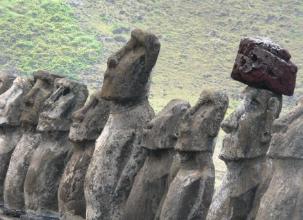Easter Island Facts...
March 3, 2007
- This island goes by the names: Rapa Nui, Easter Island and Isla de Pascua.
- This was named ‘Easter Island’ by a Dutch explorer in 1722 because he discovered it on Easter day.
- This is one of the most remote inhabited places on earth.
- There are over 900 moai on the island.
- During the civil wars, every single moai was toppled over. None were left standing. The ones currently standing are because of
restoration projects.
- The moais face the villages to bring them protection.
- Rapa Nui is considered the largest open air museum in the world.
- Rapa Nui is now in the country of Chile (even though it is technically in Polynesia).
- Rapa Nui is the native language here. The second language is Spanish. The third language is French due to being ‘close’ to
Tahiti (which is in French Polynesia).
- Everything about the island screams ‘Polynesia’. Well, with the exception of hearing Spanish and eating empanadas.
- The island officially became Chilean on September 9, 1888. At this point, the population was down to just over 100 people.
- A French missionary from Valparaiso came here in 1864 to convert the islanders to Christianity.
- On August 14, 1866 almost all of the islanders were baptized in a ceremony.
- Churches have merged ‘Rapa Nui’ with Catholicism. Masses are held in the mother tongue (of Rapa Nui).
- After the civil wars, there was a birdman (Tangata Manu ritual) competition every year to determine the leader of Rapa Nui.
Each clan would pick a leader to participate. The person would swim across shark-infested waters in search for an egg of a
manutara. Upon bringing it back, that person would be the new leader. The person would be completely shaved and would let
their fingernails grow. Somehow, this kept the peace. This lasted until 1867.
- Rano Raraku is the volcanic stone quarry. This is where they got the raw material used to construct the moai. They started
this in 900 AD. Construction continued until the civil wars broke out in the 17th century. About 397 moai are scattered
around in different stages of construction.
- Ahu Tongariki is the largest platform with fifteen moai. In 1960 a tsunami flooded the area and the remains of the fifteen moai
were scattered around a 100-meter radius. It was restored between 1992 and 1996 by Chilean archaeologists and funded by
Japanese government.
- There are lots of caves on Rapa Nui.
- The largest moai weighs 80 tons and is 11-meters long.
- It is not allowed to step on platforms or statues. To do so (or to mark the stone) is considered a crime considering these are
sacred sites.
- It is also not allowed to pick up stones or to take them away as souvenirs.
| The guys of Ahu Tongariki! |
